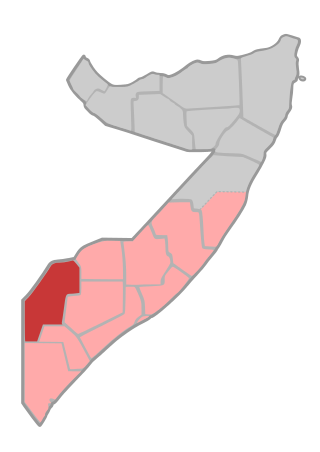
Gedo is an administrative region (gobol) in Jubaland, southern Somalia. Its regional capital is Garbahaarreey. It was created in 1974 and is bordered by the Ogaden in Ethiopia, the North Eastern Province in Kenya, and the Somali regions of Bakool, Bay, Jubbada Dhexe, and Jubbada Hoose further down east. The southern parts of Gedo, west of the Jubba River, used to be part of the old British Trans-Juba region during half of the seventy years of colonial era in Africa from 1890 to 1960. The British and Italians fought twice over this area. The first democratically elected governor of the administrative region was Hussein Farey, who entered office in 2008.

Middle Juba is an administrative region (gobol) in southern Somalia. With its capital at Bu'aale, it is located in the autonomous Jubaland region.
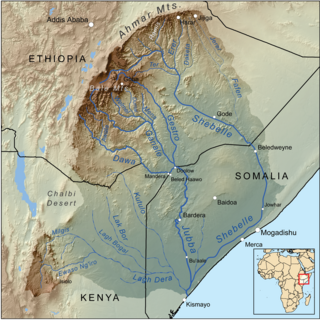
The Jubba River or Juba River is a river in southern Somalia which flows through the autonomous region of Jubaland. It begins at the border with Ethiopia, where the Dawa and Ganale Dorya rivers meet, and flows directly south to the Somali Sea, where it empties at the Goobweyn juncture. The Jubba basin covers an area of 749,000 km2 (289,000 sq mi). The Somali regional state of Jubaland, formerly called Trans-Juba, is named after the river.
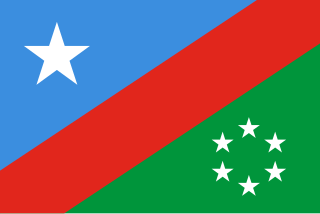
The South-West State of Somalia, is a Federal Member State in southwestern Somalia. It was founded by Hasan Muhammad Nur Shatigadud, leader of the Somalia RRA on 1 April 2002. It was the third autonomous region to be established.

Somalia is a federal republic consisting of six federal states, Puntland, Jubaland, Galmudug, [, South West and Hirshaabelle and one interim administration. Somalia is further subdivided into 18 administrative regions, which are in turn subdivided into districts. One region, Banaadir, is not part of any state.

Kismayo is a port city in the southern Lower Juba province of Somalia. It is the commercial capital of the autonomous Jubaland region.

Bardere also known as Bardera, is a city in Jubaland State of Somalia. It is the second largest and most populous city in Jubaland with Kismayo being the largest and most densely populated city in the region. Bardere sits on the Jubba River around 250 km west of the city of Baidoa and is in a highland area with fertile soil.
Following the civil war and the ensuing societal chaos, some factions managed to exert a degree of authority over certain regions of Somalia where they maintained broad, clan-based support. This allowed these factions to establish working administrations and eventually coherent states, and restored order to their regions. This occurred first in Puntland, Southwestern Somalia, Galmudug, Jubaland and finally Banadir.
Aden Aw Hirsi is a Somali politician and author. The current Minister of State for Environment & Climate Change of Somalia, he previously served as the Minister of Planning & International Cooperation of Jubaland State among other different important portfolios.
Burdhubo is a town in the southern Gedo region of Somalia jubaland state. It is the center of the Burdhubo District.
El Wak is a town located in the southwestern Gedo region of Jubaland. Situated by the Somalia-Kenya border, it is 9 km away from El Wak, Kenya and just 4 km away from the international border.

Luuq is a city in the southwestern Gedo province of Somalia. It is one of the older settlements in the area. It is the seat of the Luuq District. The town is located in a bend of the Juba River, where the watercourse flows down from north to south in a horseshoe shape. Luuq is also known as Luuq Gan naane.

Sheikh Ahmed Mohamed IslaamMadobe is a Somali politician who served as the 1st President of the Jubaland State of Somalia from 2013 to 2023.
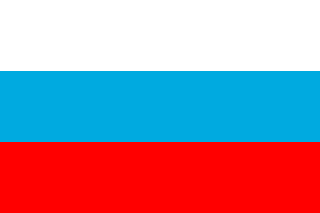
Azania, officially the Republic of Azania, was a self-proclaimed autonomous state of Jubaland in southern Somalia that existed from 2011 to 2013. A group of Somali politicians proclaimed the creation of Azania on 3 April 2011 in Nairobi, with Mohamed Abdi Mohamed as its President. The state's main intentions were to contest al-Shabaab, which largely controlled Jubaland.
Ahmed Farah Dualeh is a Somali-Danish community worker and politician. He is the President of Jubaland, a region comprising the three Jubba Valley regions of Gedo, Middle Jubba and Lower Jubba.

Jubaland, the Juba Valley, is a Federal Member State in southern Somalia. Its eastern border lies 40–60 km (25–35 mi) east of the Jubba River, stretching from Dolow to the Indian Ocean, while its western side flanks the North Eastern Province in Kenya, which was carved out of Jubaland during the colonial period.
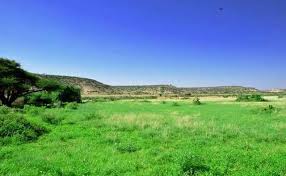
Iskufilan is a small town in the southern Gedo region of Somalia. It is situated between Bardera and El Adde, in the autonomous Jubaland region. It has a primary school and a hospital. The town is settled mainly by the Shirwac Diini subclan of the larger Marehan clan.

Jubaland has had a wide array of flags in its modern history, ranging from that during its British East Africa Province of Jubaland era, during the transitionary Trans-Juba period of Jubaland, as well as the current Jubaland's federal state flag.

Division 43, Somali National Army is a division of the Somali National Army. Focused on the southern part of the country, it is headquartered in Kismayo and covers the state of Jubaland.
![]() |Proportion = 1:2 |Adoption = October 15, 1998 |Design = A horizontal tricolor of [[blue], White, and red with the 5-pointed star charged on the same stripe. |Type = Regional }} The flag of Gedo is used in Gedo, a region in Jubaland state of Somalia. [1] [ verification needed ]
|Proportion = 1:2 |Adoption = October 15, 1998 |Design = A horizontal tricolor of [[blue], White, and red with the 5-pointed star charged on the same stripe. |Type = Regional }} The flag of Gedo is used in Gedo, a region in Jubaland state of Somalia. [1] [ verification needed ]











